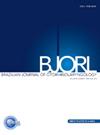Effectiveness of hypertonic saline irrigation following functional endoscopic sinus surgery: a systematic review and meta-analysis
IF 1.7
4区 医学
Q2 OTORHINOLARYNGOLOGY
引用次数: 0
Abstract
Objectives
This study aimed to clarify the impact of hypertonic solutions on various outcomes, including persistence or reduction of nasal crusts, polypoid edema, and postoperative inflammatory symptoms.
Methods
We searched PubMed, Embase, and Cochrane Central Register of Controlled Trials for studies comparing hypertonic with isotonic saline irrigation after FESS in adult patients with Chronic Rhinosinusitis (CRS). Outcomes were polypoid mucosa, nasal crusts, and variation from the baseline of Sino-Nasal Outcome Test (SNOT) 20/22 and Visual Analog Scale (VAS). For statistical analysis, we used RevMan 5.4.1, and assessed heterogeneity with I2 statistics.
Results
We included a total of 479 patients from 7 studies. In the hypertonic saline group, there was a reduction in the nasal crust Risk Ratio (RR) (RR = 0.65; 95% CI 0.49 to 0.87; p = 0.004; I2 = 0%) after 30–45 days and severe crusts at 14–21 days (RR = 0.59; 95% CI 0.38 to 0.91; p = 0.02; I2 = 0%). Additionally, the persistence of polypoid mucosa was lower in the intervention arm (RR = 0.53; 95% CI 0.43 to 0.65; p < 0.00001; I2 = 0%) after 14–21 days. In the symptomatic evaluation hypertonic saline group showed an improvement in postoperative symptoms by a VAS Mean Difference (MD) (MD = −5; 95% CI −5.77 to −4.24; p < 0.00001; I2 = 0%) and a SNOT 20/22 Standard Mean Difference (SMD) (SMD = −1.65; 95% CI −2.7 to −0.61; p = 0.002; I2 = 93%) reduction from baseline in 30–45 days after the surgery.
Conclusion
Hypertonic saline showed a superior improvement in postoperative evaluation by means of nasal crusting, mucosal healing aspect, and nasal inflammatory symptoms compared with isotonic saline irrigation.
功能性内窥镜鼻窦手术后高渗盐水冲洗的效果:系统综述和荟萃分析
本研究旨在阐明高渗溶液对各种结果的影响,包括鼻痂、息肉样水肿和术后炎症症状的持续或减轻。方法我们检索了 PubMed、Embase 和 Cochrane Central Register of Controlled Trials 等文献,比较了慢性鼻窦炎(CRS)成人患者 FESS 术后高渗和等渗生理盐水灌洗的研究。研究结果包括息肉状粘膜、鼻腔结痂、中鼻结果测试(SNOT)20/22 和视觉模拟量表(VAS)与基线的差异。我们使用 RevMan 5.4.1 进行了统计分析,并用 I2 统计量评估了异质性。在高渗盐水组中,30-45 天后鼻痂风险比 (RR) 降低(RR = 0.65;95% CI 0.49 至 0.87;p = 0.004;I2 = 0%),14-21 天后严重鼻痂风险比降低(RR = 0.59;95% CI 0.38 至 0.91;p = 0.02;I2 = 0%)。此外,14-21 天后,干预组的息肉状粘膜持续性较低(RR = 0.53;95% CI 0.43 至 0.65;p < 0.00001;I2 = 0%)。在症状评估中,高渗盐水组的术后症状有所改善,VAS平均差(MD)(MD = -5; 95% CI -5.77 to -4.24; p < 0.00001; I2 = 0%)和SNOT 20/22标准平均差(SMD)(SMD = -1.65; 95% CI -2.7 to -0.结论与等渗盐水灌洗相比,高渗盐水通过鼻腔结痂、粘膜愈合方面和鼻腔炎症症状对术后评估有更好的改善作用。
本文章由计算机程序翻译,如有差异,请以英文原文为准。
求助全文
约1分钟内获得全文
求助全文
来源期刊

Brazilian Journal of Otorhinolaryngology
OTORHINOLARYNGOLOGY-
CiteScore
3.00
自引率
0.00%
发文量
205
审稿时长
4-8 weeks
期刊介绍:
Brazilian Journal of Otorhinolaryngology publishes original contributions in otolaryngology and the associated areas (cranio-maxillo-facial surgery and phoniatrics). The aim of this journal is the national and international divulgation of the scientific production interesting to the otolaryngology, as well as the discussion, in editorials, of subjects of scientific, academic and professional relevance.
The Brazilian Journal of Otorhinolaryngology is born from the Revista Brasileira de Otorrinolaringologia, of which it is the English version, created and indexed by MEDLINE in 2005. It is the official scientific publication of the Brazilian Association of Otolaryngology and Cervicofacial Surgery. Its abbreviated title is Braz J Otorhinolaryngol., which should be used in bibliographies, footnotes and bibliographical references and strips.
 求助内容:
求助内容: 应助结果提醒方式:
应助结果提醒方式:


